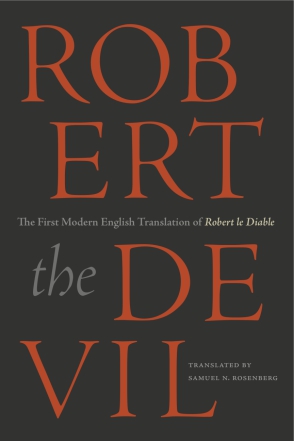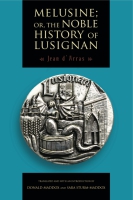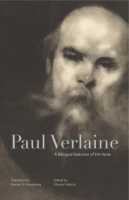
Robert the Devil
The First Modern English Translation of Robert le Diable, an Anonymous French Romance of the Thirteenth Century
Translated by Samuel N. Rosenberg
Robert the Devil
The First Modern English Translation of Robert le Diable, an Anonymous French Romance of the Thirteenth Century
Translated by Samuel N. Rosenberg
“An excellent translation that will appeal to medieval enthusiasts, fans of chivalric romance, and French literature.”
- Description
- Reviews
- Bio
- Table of Contents
- Sample Chapters
- Subjects
Robert is born after his mother, a childless noblewoman, secretly calls upon Satan to help her conceive. His wicked behavior as a boy and, later, as a destructive young man is so brutal that one day Robert prevails upon his mother to reveal the secret of his birth and thus the source of his wickedness. Upon learning the truth, he leaves his privileged home in Normandy to seek salvation. Robert’s lengthy penance—under the aegis of the Pope and a pious hermit—begins with his acting as a mute fool in the Roman Emperor’s court and ends with his sainthood. In between he plays the hero’s role in defeating the Turks in battle and turns down the hand of the Emperor’s daughter in marriage, choosing instead to return to the hermit’s abode.
The legend of Robert le Diable was extraordinarily influential in the seven hundred years after its creation, generating new versions and adaptations in various languages, ranging from sixteenth-century English adaptations by Wynken de Worde and Thomas Lodge to Giacomo Meyerbeer’s esteemed 1831 opera. Framed by a thoughtful introduction and thorough bibliography, this accessible translation renders the original octosyllabic rhymed couplets of the metrical Old French romance in energetic free verse.
“An excellent translation that will appeal to medieval enthusiasts, fans of chivalric romance, and French literature.”
“A welcome, engaging translation of an often underrated romance.”
“A welcome addition to the slew of recent translations of less-known French romances.”
“This elegant translation makes the thirteenth-century Old French saint’s legend of Robert le diable available to an English-speaking audience for the first time. The poem, rendered here into vigorous free verse that captures the spirit of the original, was extremely popular (and widely translated) in the Middle Ages, but has been relatively neglected by modern scholars. Samuel Rosenberg includes an excellent introduction and bibliography. I recommend the volume highly.”
“Samuel N. Rosenberg is one of the most accomplished and capable translators of Old French texts working today. He has now applied his admirable skills to Robert le Diable, a fascinating romance of the thirteenth century.”
“Rosenberg’s lively, yet faithful rendition of this classic tale is a welcome addition to the corpus of works in Old French now available to a wider audience. The legend’s vitality in the various adaptations it has assumed, along with Robert’s devilish charisma, make the text an important subject for further research in genre and character studies.”
“Translations should be measured against their purpose, and Rosenberg easily meets his declared intentions. This is ‘a work suitable for recitation, a work whose rhythms and sonorities bespeak the presence […] of a storyteller.’ Whether as teaching aid or pleasure read, this translation of Robert’s tale brings medieval Europe to life with aplomb.”
Samuel N. Rosenberg was Professor Emeritus of French and Italian at Indiana University. He edited and translated numerous works, including Paul Verlaine: A Bilingual Selection of His Verse and Robert de Reims: Songs and Motets, both published by Penn State University Press.
Contents
Acknowledgments
Introduction
Robert the Devil
Notes
Bibliography
Index
From the Introdution
The Work
Robert le Diable—an anonymous French roman d’aventures—has roots no doubt going down into, pre-Christian folkloric materials, for an account of human birth through divine or supernatural agency is clearly not an invention of the European Middle Ages. As fully recounted for the first time in a manuscript of the thirteenth century and provided with a historically and geographically plausible setting, it is basically the tale of a boy born to a childless noble couple only after the mother has secretly called on Satan to help her conceive. The behavior of the boy, and then of the strong, powerfully built young man skilled at arms that he becomes, is so destructive and brutal that one day, loathing himself, he prevails on his mother to reveal the secret of his birth and thus the source of his wickedness. He leaves his home in Normandy, as well as his privileged position as the only child of the Duke, to seek salvation in Rome. The Pope and then a pious hermit set him on the way to remission of his sins through a lengthy, arduous penance, whose most striking requirement is that he never speak. Living dumbly at the Roman court as the Emperor’s pet fool, Robert becomes aware of a Turkish threat of invasion. He prays to God to allow him to use his ever-extraordinary strength and fighting ability to help the Romans, though without revealing his identity. Thanks to an angelic emissary of the Lord, Robert is able to accomplish his desired mission. The Saracens are persistent enemies, however, and it is only after three successive military campaigns that they are finally defeated, the Romans all the while wondering who their elusive champion might be. Robert’s identity has been known all along to the Emperor’s daughter but has remained a secret, because she, like Robert, is mute (but for nonpenitential reasons). Dramatic events, involving a villainous seneschal rejected as a suitor to the Princess, ultimately restore the power of speech to both Robert and the Emperor’s daughter. The Emperor, grateful for Robert’s decisive help against the Turks, wishes to grant him his very willing daughter in marriage. Robert declines, however, and returns to the hermit’s abode, where his path to salvation began. When Robert dies, he is venerated as a saint.
The tale touches on a remarkably broad range of medieval concerns, from genealogy and the shaping of character to all the manifestations, implications, and effects of transgression. The problem of sin, personal responsibility, and penitence is a central issue, as is the transformation of an outsized epic warrior into a self-effacing saint. The nested questions of divine justice, pontifical authority, the penitential value of silence and anonymity, and eremitic charity are essential to the unfolding of the story, but no element of the legend could be more excitingly central than the all-consuming conflict between Christendom and the Muslim world in these days of an ongoing Crusade. Along the way, the narrative provides engaging insights into the mores of the papal court in Rome, from the seating of the various diners at a banquet and the polite order of hand washing to the treatment of a disabled princess and the early employment of sign language.
The romance has come down to us in 5,078 lines of rhymed octosyllabic couplets, transmitted (along with three other romances) in a manuscript from the second half of the thirteenth century, fr. 25516 of the Bibliothèque nationale de France. Large, colored capital letters open the various sections of the manuscript; these are represented in our transcription by large capital letters. There is a second redaction, somewhat different and slightly briefer, preserved in a manuscript of the late fourteenth or early fifteenth century, BnF fr. 24405. The first of these versions (A), published in Eilert Löseth’s unsurpassed critical edition of 1903, is the text that underlies our English translation, as it does the modern French translation by Alexandre Micha. The second version (B) is the basis for Élisabeth Gaucher’s edition and modern French translation (see the bibliography).
Later Versions
The tale of Robert the Devil is clearly a gripping story, for very soon after the writing of version A, it was worked into a Latin exemplum in Lyon by the Dominican monk Étienne de Bourbon. It appeared in the decade of the 1250s in his Tractatus de divesis materiis predicabilibus as an abridged retelling, the didactic purpose of which was to demonstrate the beneficent effects of penance.
This version was followed by another pious treatment in Latin, notably as an exemplum cited by the Dominican Jean Gobi in his Scala coeli for its lesson in the appeasement of divine wrath. Gobi’s version was still used by Franciscan preachers in southern Italy at the end of the fifteenth century.
A short version of the legend was transmitted in the thirteenth century in the first Chronique de Normandie, an anonymous Norman history in French prose. This was succeeded around the middle of the following century by a longer version, attributed to one Anonyme de Béthune. The unknown author of this rewriting, called the Grande Chronique de Normandie, was probably a native of Normandy or Picardy.
The appeal of the story remained powerful. If the Grande Chronique relates it as a sort of history, the equally anonymous Dit de Robert le Diable, composed in the first half of the fourteenth century, appears to have made use of it for moral instruction. In this instance, version A of the tale was condensed into a sequence of 254 quatrains of monorhymed alexandrines.
Further rewritings, with a significant change of genre, also appeared in the fourteenth century. In two notable cases, adaptation of the legend entailed a move to the dramatic stage. There is, first, an anonymous mystère, the scenic details of which are not known, but a modern French adaptation of it, written by the historian Édouard Fournier, was performed in 1878 and published in the following year. The American poet W. S. Merwin later wrote an English translation of the French adaptation.
The other fourteenth-century rewriting for the theater is the Miracle de Robert le Diable, number 33 in the forty-piece collection of Miracles de Notre Dame par personnages, a play apparently performed between 1339 and 1350 by and for the Confrérie Saint-Éloi, the guild of goldsmiths of Paris; the unknown author, no doubt of Norman or Picard origin, based his text on the Dit de Robert le Diable.
The legend of Robert the Devil entered the age of printing in 1496, when the Dit de Robert le Diable was rewritten in Lyon as a prose text, called La Vie du terrible Robert le Diable. Between that date and 1580, eleven editions reproduced the same text, including seven in Paris, with a total printing of more than a thousand copies. This prose text was the model for the version that came to be sold in the following century in the Bibliothèque Bleue.
The creation of the Bibliothèque Bleue in the early 1600s led to a proliferation of chapbooks throughout France. Right through the following two centuries, the prose Vie de Robert le Diable remained a best seller, prized for its tale of chivalric prowess in the face of a faithless foe, a touchingly chaste love, and, no doubt particularly, moral edification, especially as a complement to the preaching of small-town and rural clergy.
In the latter part of the eighteenth century, the scholarly journalist Jean de Castilhon composed a new, augmented version of the legend, with various new episodes and commentary, intended for a more sophisticated readership. Published in 1769 and then reprinted, it was released in 1784 in a condensed version meant, again, for an upper-class public, the contemporary bourgeoisie. Castilhon’s new conception of the story entails considerable ideological, cultural, and narrative updating. This is no small shift from the medieval tale of version A.
Numerous editions and revisions followed in the nineteenth century, with notable efforts to counteract the would-be modernizing tendencies of Castilhon and revert to the alleged naive and wholesome simplicity of the original legend. Such efforts, located within the Nouvelle Bibliothèque Bleue, were led by the influential Romantic writer Charles Nodier and supported by the extensive philological and historical work of Antoine Le Roux de Lincy.
Surely, the most startling remaking of the tale in the nineteenth century came in the form of an adaptation for the operatic stage. This was the work of the composer Giacomo Meyerbeer and the very well-known Parisian playwright-librettist Eugène Scribe. Their groundbreaking grand opera, produced for the first time in 1831, had an unprecedented success, with further stagings in the same decade not only in European cities but in the Americas as well, including New York, New Orleans, and Mexico City. Numerous critics, French and foreign, were quick to voice enthusiastic approval and disapproval, but performances long remained a staple of the Paris Opéra, the most recent production being a brilliant revival in 1985. The Romantic tale presented by Meyerbeer and Scribe is an adaptation of the legend unimaginable in earlier years, yet, in retrospect, understandable as a further refashioning in a long line of attempts to make a new use of age-old material. Various cinematic treatments of the legend have also appeared in France and elsewhere.
The legend of Robert the Devil, immensely popular in late medieval France, spread quite early to Spain and eventually to the Netherlands, Germany, and Italy. In fourteenth-century England, the unknown writer of Sir Gowther turned the tale into a metrical romance, and other English adaptations, by Wynkyn de Worde and by Thomas Lodge, appeared in the sixteenth century. In the twentieth century, as mentioned earlier, the poet W. S. Merwin published an English translation of a fourteenth-century French stage version of the legend.
The Translation
This is the first translation of the thirteenth-century French work into modern English, done from the critical edition prepared by Eilert Löseth for the Société des Anciens Textes Français, published in 1903. The five thousand verses of Old French text, presented by its editor in numbered lines of rhymed octosyllabic couplets, appear in the present translation with Löseth’s line numbering. The section divisions usually repeat those of the edited text, with the major difference that all passages of dialogue in the translation are preceded and followed by spaces to make the story easier to follow. The translation is in free, rhythmic verse, carrying a narrative meant to convey, like the original, the rhythm of a reciting voice. Indeed, the goal in the translation, as it was in the original text, is to create a work suitable for recitation, a work whose rhythms and sonorities bespeak the presence, now even on paper, of a storyteller. English lending itself much less readily than French to sustained rhyming, the translation has rhyme and assonance appearing regularly only in the final couplets of key sections and passages of dialogue. Elsewhere, there is abundant use of alliteration and of other homophonic echoes. Note that the narration includes many insertions by the jongleur; some are mere phrases, while others are extended remarks. In any case, the jongleur’s presence through the text is an inescapable fact. The translated text, like the manuscript and the edited French text, does not signal the jongleur’s insertions typographically.
Lexical choices inevitably include terms that are obviously congruent with the medieval subject matter, but they avoid vocabulary that is gratuitously quaint or archaic. The effort throughout is to offer a smoothly resonant English text that recounts its medieval tale in fittingly modern language.
(Excerpt ends here)
Mailing List
Subscribe to our mailing list and be notified about new titles, journals and catalogs.







